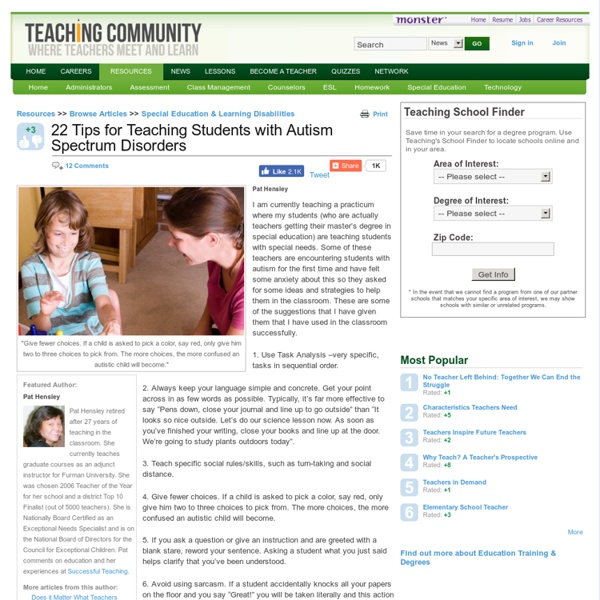22 Tips for Teaching Students with Autism Spectrum Disorders
Resources >> Browse Articles >> Special Education & Learning Disabilities "Give fewer choices. If a child is asked to pick a color, say red, only give him two to three choices to pick from. The more choices, the more confused an autistic child will become." Featured Author: Pat Hensley Pat Hensley retired after 27 years of teaching in the classroom. I am currently teaching a practicum where my students (who are actually teachers getting their master’s degree in special education) are teaching students with special needs. 1. 2. 3. 4. 5. 6. 7. 8. 9. 10. 11. 12. 13. 14. 15. Teaching Career Links The Most Comprehensive Teacher Salary Guide on the Internet Read now.Certification Requirements for U.S. 16. 17. 18. 19. 20. 21. 22. Need more tips?
Commentary: Early childhood education boosts economic, social...
One of the earliest indicators of a child’s future success is the number of words he or she hears prior to kindergarten. Language development begins with the interplay of words between the parent and child and helps nurture vocabulary, which is considered the building block of education. The frequency and richness of natural conversation in a child’s first years plays a key role in development. An at-risk child who lacks these early interactions often enters kindergarten with a vocabulary 18 months behind that of a middle-income child. As the child ages, the gap widens instead of narrowing. With vocabulary proficiency such a vital marker of a child’s capacity to learn, the child risks falling so far behind that his or her prospects for graduating high school or finding a meaningful job are greatly diminished. The issue of school preparedness has further relevance as we compete in a world economy increasingly fueled by a knowledge-based workforce.
The Effects of Imitative Vs. Cognitive Methods on The Speech Development of Children With Autism
Abstract | Full Text <p><strong>How to Cite This Article:</strong> Jalili M, Jahangiri N, Yazdi Aa, Ashrafzadeh F. The Effects of Imitative Vs. Cognitive Methods on The Speech Development of Children With Autism.
American Educational History Timeline
American Educational History: A Hypertext Timeline Last updated September 13, 2017. See the lesson plan designed for use with this timeline. This page was scanned for broken links and updated on August 14, 2017. However, it is virtually impossible to keep them all current. If you find a broken link, please let me know. 1607 – The first permanent English settlement in North America is established by the Virginia Company at Jamestown in what is now the state of Virginia. 1620 - The Mayflower arrives at Cape Cod, bringing the "Pilgrims" who establish the Plymouth Colony. 1635 - The first Latin Grammar School (Boston Latin School) is established. 1635 - The first "free school" in Virginia opens. 1636 - Harvard College, the first higher education institution in what is now the United States, is established in Newtowne (now Cambridge), Massachusetts. 1638 - The first printing press in the American Colonies is set up at Harvard College. 1640 - Henry Dunster becomes President of Harvard College.
Inclusion of Learners with Autism Spectrum Disorders in Gene... : Topics in Language Disorders
A pivotal element of the Reauthorization of the Individuals with Disabilities Act in 1997 is the inclusion of children and youth with disabilities, including those with autism spectrum disorders (ASD), in general education classrooms. The challenges of including students with ASD are many because of the nature and severity of their disability. In this regard, the Autism Spectrum Disorder Inclusion Collaboration Model offers guidelines and supports that can facilitate the successful inclusion of children and youth with autism and related disabilities. THE WORK of pioneers such as Kanner (1943) and Asperger (1944) graphically portrayed persons with an autism spectrum disorder (ASD) as perplexing and mystifying individuals. Over the decades this enigmatic legacy has continued. Independent of the exact nature and severity of their disability, all children and youth with ASD require careful individualized planning to experience educational success.
Related:
Related:



